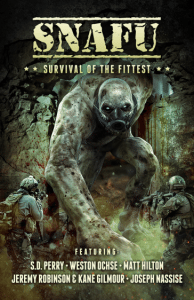
Edited by Geoff Brown and Amanda J Spedding
Cohesion Press
2015
Reviewed by Michael R. Collings
The fourth entry in the highly readable series of SNAFU anthologies lives up to the premise and the promise of the first volumes. In this case, the sole survivor (occasionally survivors) of an armed encounter with the unknown, the incomprehensible, the outré, or the arcane must exceed all expectations and, often wounded and apparently dying, continue the battle to the ultimate end…of the human or of his (usually) inhuman foe. Along the way, the authors treat readers to an enviable variety of times, places, landscapes, and characters, enough to hold interest from first story to last.
Because this volume concentrates on survival, the stories depend on the extent to which the foes are legitimate threats and themselves exceed expectations; there must be a sense of viable opposition for the theme to develop fully. And viable opposition there is, in full-flown, imaginative glory. Consider the following from among the creatures highlighted:
-The gangshi, Korean zombie-creatures who use a curious hopping movement to invade and destroy destroy the remnants of a MASH unit in 1952—a unit whose personnel bear a remarkable resemblance to another, better-known M*A*S*H unit, thus contributing a touch of the comedic to an otherwise nicely gruesome tale;
The galdr, gruesome creatures summoned by a circle of witches as a last resort in battling the defending armies of Norway’s tenth-century king, Harald Greycloak, represented through much of the story by the axe-man Bard, unbowed and undeterred by the prospect of confronting the supernatural;
-Vicious and voracious creatures set sentinel to ensure that no strangers ever penetrate a complex maze of caves and tunnels north of Kandahar, Afghanistan—until Team Epsilon dares to follow fleeing insurgents…and discovers that the depths contain not only death but things far worse;
-Immortal Templers, unsleeping guardians of a secret temple deep in the forests of Vietnam, protecting it against incursions of outlanders desperate to unravel its mysteries and, in the process, gain immortality for themselves—and what chance do mere mortals, even seasoned veterans, stand against the undying;
Alien invaders that systematically inflict unbearable pain and grisly death on helpless human colonists, unstoppable by any usual means, until they encounter one of the most fantastic (in multiple senses) protagonists in the entire SNAFU series;
-Dracula, the original Vlad the Impaler, “devourer of children and sucker of souls,” released from centuries-long imprisonment in Tokat Castle by a small detachment of soldiers who assumed—believed—that they were prepared for anything;
-Psychic controllers, Soviet and Chinese, using demon-possession and warlocks to infiltrate an enclave of immensely powerful men, opposed by Special Unit 77 (familiar to readers from earlier stories);
Formless scarlet jelly-things, rather like the 1950s nightmare in The Blob, mutated into consciousness and determined to engulf all of humanity within its amorphous self;
The ultimate creature waiting at the end of The Slog—a tortuous trek through the blood-soaked wilds of Vietnam known in whispers and feared by all, the landscape perfectly described as “islands of madness in a quiet, uncaring sea”; and
-Gigantic, mystical worms living in the depths of the Mongolian desert, distant cousins, perhaps, of the Graboids of Tremors or the Sandworms of Dune—immense, unstoppable, and roused from somnolence by an otherwise innocuous raid on an enemy R-and-D facility.
The fascinating thing about SNAFU: Survival of the Fittest is that this array of disparate monsters fits perfectly; one story might take place half a millennium and half a world away from the next—or even on another world—yet the tone, the sense of human or human-surrogates in mortal peril connects them all. The characters rarely become ciphers to be moved across a pre-determined stage; the monsters are vital and intriguing, both those familiar and those entirely new; and the landscapes…well, the landscapes are often as integral to the stories as the characters themselves.
“The Slog,” for example, transforms the Vietnam of memory into a bloody nightmare peopled by the dead, highlighting the ultimate inadequacy and obscenity of warfare—all warfare. As Luke literally slogs his way through death and darkness, he simultaneously and symbolically slogs his way through life, with only one possible outcome. And the alien contours of “Fallen Lion” matches the unexpected nature of two key combatants: the lancer Brokehorn and the bladejaw Ripper…better known through their English names, triceratops and tyrannosaurus.
Of the four volumes thus far, Survival of the Fittest is arguably the most cohesive, certainly the most enjoyable for me to read. Every story was well-chosen; every author represented by solid, engaging storytelling, and every conclusion (even to those stories that are part of continuing narratives) inevitable and, at the same time, wonderfully surprising.








